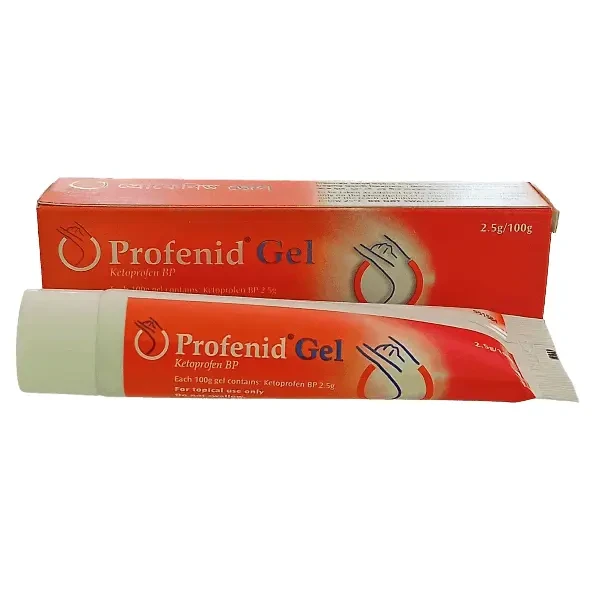30 gm tube:
৳ 120.36
Indications
Profenid gel is indicated for the symptomatic treatment of mild to moderate local pain associated with muscle and/or joints injuries, e.g. sport injuries.
Pharmacology
Ketoprofen is a non-steroidal anti-inflammatory drug (NSAID) with analgesic and antipyretic actions. In addition to the inhibition of prostaglandin synthesis, it stabilizes lysosomal membranes in vitro and in vivo, inhibits leukotriene synthesis in vitro at high concentrations, and also exhibits antibradykinin activity in vivo. Ketoprofen produces analgesia by inhibiting the synthesis of prostaglandins peripherally and centrally. It has also been suggested that Ketoprofen causes the suppression of prostaglandin synthesis in the CNS (probably in the hypothalamus) leading to its antipyretic effect.
Dosage & Administration
Adults: The gel should be applied on to the painful or inflamed area two to three times daily. The amount of gel should be adjusted so that it covers the painful area. The total daily dose shall not exceed 15 grams per day. The length of treatment should not exceed one week. The gel should be massaged onto the skin for a few minutes.
Children: The safety and efficacy of Ketoprofen gel in children have not been established.
Children: The safety and efficacy of Ketoprofen gel in children have not been established.
Interaction
Interactions are unlikely as serum concentrations following topical administration are low.
Contraindications
Ketoprofen gel must not be used in patients with:
- Known hypersensitivity reactions, such as symptoms of asthma, allergic rhinitis or urticaria, to ketoprofen, fenofibrate, tiaprofenic acid, acetylsalicylic acid, or other non-steroidal anti-inflammatory agents.
- History of hypersensitivity to any of the excipients.
- History of photosensitivity reactions.
- History of cutaneous reactions to ketoprofen, tiaprofenic acid, fenofibrate, UV blockers or perfumes.
Side Effects
Immune System disorders- Not known: Anaphylactic shock, angioedema, hypersensitivity reactions.
Gastrointestinal disorders- Although plasma levels after administration of Profenid gel are much lower than those reached after oral administration, systemic gastrointestinal side effects (such as nausea, abdominal pain, vomiting, and flatulence) are possible under rare circumstances depending on the amount of gel applied and the application of the gel to a large area of skin. Uncommon: Nausea. Not known: Abdominal pain, vomiting, flatulence.
Skin and Subcutaneous tissue disorders- Uncommon: Erythema, pruritus, eczema. Rare: Photosensitivity reactions, dermatitis bullous, urticaria. Localised skin reactions have been reported which may spread outside the application site. Not known: Burning sensations, Stevens-Johnson syndrome.
Renal and Urinary disorders- Very rare: Worsening renal insufficiency.
Gastrointestinal disorders- Although plasma levels after administration of Profenid gel are much lower than those reached after oral administration, systemic gastrointestinal side effects (such as nausea, abdominal pain, vomiting, and flatulence) are possible under rare circumstances depending on the amount of gel applied and the application of the gel to a large area of skin. Uncommon: Nausea. Not known: Abdominal pain, vomiting, flatulence.
Skin and Subcutaneous tissue disorders- Uncommon: Erythema, pruritus, eczema. Rare: Photosensitivity reactions, dermatitis bullous, urticaria. Localised skin reactions have been reported which may spread outside the application site. Not known: Burning sensations, Stevens-Johnson syndrome.
Renal and Urinary disorders- Very rare: Worsening renal insufficiency.
Pregnancy & Lactation
- During the first and second trimester: As the safety of ketoprofen in pregnant women has not been evaluated, the use of Ketoprofen during the first and second trimester of pregnancy should be avoided.
- During the third trimester: During the third trimester of pregnancy, all prostaglandin synthetase inhibitors including ketoprofen may induce cardiopulmonary and renal toxicity in the fetus. At the end of the pregnancy, prolonged bleeding time in both mother and child may occur.
- Ketoprofen is not recommended in nursing mothers.
Precautions & Warnings
- The gel should be used with caution in patients with reduced heart, liver or renal function.
- The gel must not be used with occlusive dressings.
- The gel must not come into contact with mucous membranes of the eyes.
- Serious skin reactions, such as Stevens-Johnson Syndrome (SJS), have been reported in association with the use of NSAIDs, including Profenid Gel. Patients should be informed about the signs and symptoms of serious skin manifestations. Treatment should be discontinued at the first appearance of skin rash, mucosal lesions, or any other sign of hypersensitivity.
- Treatment should be discontinued immediately upon development of any skin reaction, including cutaneous reactions after co-application of octocrylene -containing products.
- Protect the treated region with clothing when outdoor, even in the absence of direct sun. This should be done during treatment with the product and for 2 weeks following its discontinuation to avoid the risk of photosensitization.
- Careful and prolonged hand washing should be carried out after each use of the gel.
Overdose Effects
Overdose is unlikely to be caused by topical administration. If accidentally ingested, the gel may cause systemic adverse effects depending on the amount ingested. However, if they occur, treatment should be symptomatic and supportive in accordance with overdosage of oral anti-inflammatory agents.
Therapeutic Class
Non-steroidal Anti-inflammatory Drugs (NSAIDs)
Storage Conditions
To be stored below 25°C. The tube should be closed after use. Keep all medicines out of the reach of children. Do not use later than the date of expiry. To be dispensed only on the prescription of a registered physician


